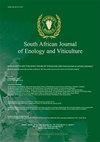Modulation of Aroma and Sensory Properties of Prokupac Wines by a Bacillus-based Preparation Applied to Grapes Prior to Harvest
IF 1.1
4区 农林科学
Q4 FOOD SCIENCE & TECHNOLOGY
引用次数: 5
Abstract
Modern viticulture requires the replacement of hazardous agrochemicals with eco-friendly, bio-based products such as microbial preparations that enhance grape and wine quality while protecting the grapevine from pest and disease attacks. This study investigated the effects of a commercially available Bacillusbased preparation on the volatile and sensory properties of wines made from Vitis vinifera, cv. Prokupac grapes. Three different concentrations of preparation based on Bacillus subtilis Ch-13 were applied to grapevines two weeks prior to harvest. The total soluble solids in the grapes was affected by the application of B. subtilis Ch-1 and the alcohol content of the wine made from these grapes was greater. Wines made from the B. subtilis Ch-13-treated grapes showed an average increase in total phenolic compounds of about 27%, compared to the wine made from the untreated control grapes. The colour intensity of wines from the treated grapes, independently of the concentration, was higher by more than 30% than for the wine from the control grape sample. The B. subtilis Ch-13 treatment also affected the content of 3-methyl-1-butanol, ethyl decanoate and ethyl octanoate in the wine, at about 35%, 40% and 20%, respectively. The latter compounds are responsible for floral and fruity aromas. Generally, wines made from the treated grapes showed similar sensorial characteristics but scored better overall than the control. Principal component analysis showed a clear differentiation between wine made from the control and that from the B. subtilis Ch-13-treated grapes. The results suggest that the application of B. subtilis Ch-13 to grapevines two weeks prior to harvest has a positive effect on wine quality.葡萄采收前芽胞杆菌制剂对Prokupac葡萄酒香气和感官特性的调节
现代葡萄栽培要求用生态友好的生物基产品取代有害的农用化学品,如微生物制剂,提高葡萄和葡萄酒的质量,同时保护葡萄藤免受病虫害的侵袭。本研究考察了市售芽孢杆菌制剂对葡萄(Vitis vinifera, cv.)酿造的葡萄酒挥发性和感官特性的影响。Prokupac葡萄。在葡萄收获前两周将三种不同浓度的枯草芽孢杆菌Ch-13制剂施用于葡萄。施施枯草芽孢杆菌Ch-1对葡萄的可溶性固形物总量有影响,使葡萄的酒精度提高。用枯草芽孢杆菌ch -13处理过的葡萄酿制的葡萄酒,其总酚类化合物的平均含量比用未处理过的对照葡萄酿制的葡萄酒高27%左右。经过处理的葡萄的葡萄酒的颜色强度,与浓度无关,比对照葡萄样品的葡萄酒高30%以上。枯草芽孢杆菌Ch-13对酒中3-甲基-1-丁醇、癸酸乙酯和辛酸乙酯的含量也有影响,分别为35%、40%和20%左右。后一种化合物负责花香和水果香味。一般来说,用处理过的葡萄酿制的葡萄酒表现出相似的感官特征,但总体得分高于对照。主成分分析表明,对照酒与经枯草芽孢杆菌ch -13处理的葡萄酒之间存在明显的差异。结果表明,采收前2周在葡萄上施用枯草芽孢杆菌Ch-13对葡萄酒品质有积极影响。
本文章由计算机程序翻译,如有差异,请以英文原文为准。
求助全文
约1分钟内获得全文
求助全文
来源期刊
CiteScore
2.50
自引率
7.70%
发文量
1
审稿时长
>36 weeks
期刊介绍:
The South African Journal of Enology and Viticulture (SAJEV) publishes full-length original Research Papers, Research Notes and Review Papers on all subjects related to enology and viticulture. The SAJEV does not accept articles published in, or submitted to, other journals.

 求助内容:
求助内容: 应助结果提醒方式:
应助结果提醒方式:


